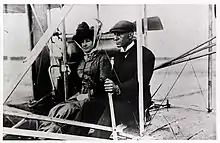
Edith Ogilby Berg was the first American woman passenger on a controlled airplane flight, flown by Wilbur Wright in September 1908 and is considered a key influence in the hobble skirt as a fashion trend. For some years she was married to Hart O. Berg, who represented the Wright Brothers' business interests in Europe.
Early life
Edith Ogilby was born in California. She was a daughter of actress Louise Paullin and Robert Edwin Ogilby, who had immigrated from Britain or Ireland to California in the Gold Rush of 1849, then became a professor of drawing at the University of California-Berkeley.[2][3] Her grandfather was Irish-born British military officer Sir David Ogilby.
Edith married Charles Bryant Titcomb in 1887 at age 19.[4] They had a daughter, Grace Titcomb. The couple divorced in 1889.
She became an actress under the stage name Edith Paullin, adopting her mother's maiden name. She appeared in some of the same productions as her second husband, the actor and producer Hubert Druce. While married to Hubert, Edith went by Edith Alice Druce until they divorced in January 1905.[5]
Life with Berg and aviation connections
Edith married Hart O. Berg in 1906 and thus met the Wright brothers. Wilbur Wright described her as “a jolly woman and very intelligent”, and his sister Katharine said Edith was "about the best dressed woman I ever saw”.[6][7]
She saw Wilbur demonstrate the Wright Flyer airplane at Le Mans, France, and asked Wilbur for a ride in it. He agreed, and on 7 October 1908 Berg rode as his passenger in a two-minute flight at nearby Auvours, France, thus becoming the first American woman to fly in a fixed-wing aircraft.[8]
On the aircraft, she tied a rope around her skirt at her ankles to keep it from blowing in the wind during the flight. A French fashion designer watching the flight noticed her walk away from the aircraft with her skirt still tied. This image is said to have influenced the subsequent hobble skirt fashion of the early 20th century.[9]
Edith had another family connection to aviation. In 1905, her daughter Grace had married Paris lawyer Paul Foy. Foy conducted the first prosecution for “furious driving in the air” in October 1909, following the crash of a Blériot monoplane into a crowd of spectators, several of whom were injured, during a display at Port-Aviation in Viry-Chatillon.[10]
Later life
Edith and Hart Berg divorced in 1922. She then used the name Edith Ogilby Titmouse Druse. She was left with $5 of inheritance from her wealthy father, with her two sisters receiving sums in the thousands.[11] She lived in the San Francisco Bay Area.[12] She died in August 1949 in San Francisco.[13]
Archives and photos
- Photo of Edith Ogilby Berg with Wilbur Wright, in National Air and Space Museum archives
- Another photo with Wilbur Wright at Hargrave: the Pioneers: Aviation and Aeromodelling.
- Photo of Mr. and Mrs. Hart O. Berg at Camp d'Auvours, Wright State University Libraries Archives
References
- ↑ "Negative No. – A 43064 B; Subject – BERG, MRS. HART O.; WRIGHT, WILBUR". Smithsonian Institution. Retrieved 2021-11-04.
- ↑ United States Census, 1870: Inhabitants in Oakland in the County of Alameda and State of California, enumerated 23 June 1870; University Faculty listing, A Directory of the City of Oakland and the Town of Alameda, Henry C. Langley, Oakland, 1874, p. 47.
- ↑ The College Courant: A Weekly Journal, Devoted to College Interests, Science, and Literature. C. C. Chatfield. 1872.
- ↑ Massachusetts State Archives: Register of Marriages in the City of Boston, 1887, Vol. 381, p. 44.
- ↑ "Hubert Druce". IMDb. Retrieved 2021-11-01.
- ↑ Anna Sproule, The Wright Brothers: The Story of the Struggle to Build and Fly the First Successful Aeroplane, Exley Publications Ltd, Watford, 1990, p. 51
- ↑ James Tobin, To Conquer the Air, Free Press, 2003, p. 337.
- ↑ Woman flies with Wright; Mrs. Hart O. Berg First of Her Sex to Ride in an Aeroplane, New York Times, 8 October, 1908, p. 1.
- ↑ D. Cochrane and P. Ramirez. Mrs. Hart O. Berg, Women in Aviation and Space History pages, National Air and Space Museum web site
- ↑ Dundee Courier, 28 October 1909, p. 8.
- ↑ "Bequeaths His Daughter $5 to Study Ingratitude". The Pamona Daily Review. May 12, 1910. p. 8.
- ↑ "Mother Scores Daughter in Will". San Francisco Bulletin. May 29, 2012. p. 8.
- ↑ Penrith Observer, 5 November 1928, p. 6; New York Times, 21 July 1940, p. 6.